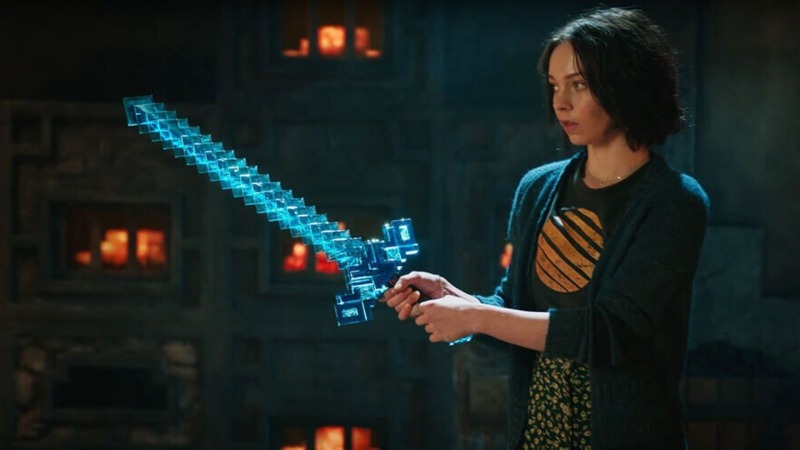Pushing Buttons: How Hollywood Addresses—or Doesn’t—Going from Playing to Watching in Videogame Adaptations

It’s no secret that videogames and cinema have a long-standing, often problematic relationship. Videogame adaptations have long carried the stigma that their mere existence means they’re bad—a consequence of inarticulately attempting to translate a very specific type of medium into one that communicates its intentions fundamentally incongruously. That, and the fact that it seemed like studios were mostly interested in exploiting popular, brand-name games for so long with little concern for whether it made for a good movie, the assumption being that the interest from fans of the game would be there regardless.
The science behind this thinking has always been dubious, as these adaptations have repeatedly proven prone to flopping. But from a broader perspective, studios have gradually become more attuned to morphing gamers’ favorite experiences into something that better reflects the soul of the source material, or at least have come to understand how to turn these properties into crowd-pleasing hits with broad appeal. Consider the critical and box office failure that was the live-action Super Mario Bros. in 1993, versus the fact that 2023’s The Super Mario Bros. Movie from Illumination is now the highest-grossing videogame movie of all time. This can partly be chalked up to cultural shifts—videogames and nerd culture are more appreciated, universal and accepted than ever—but it’s also the result of a more self-aware filmmaking system that has gone back to the drawing board on how a videogame movie can actually deliver a hit.
Recent weeks have seen the biggest box office success for videogame adaptations since Mario, with A Minecraft Movie (part of the winning formula, apparently: just add “Movie” to the title), which claimed the title of second-highest-grossing videogame adaptation within three weeks of release. It arrives just months after Sonic the Hedgehog 3, which currently sits in the number three spot. Beyond the fact that these are all properties aimed primarily at a younger demographic, there’s something to be said for Hollywood’s evolving approach to adapting an object designed to be interactive into the more passive form of cinema.
Including A Minecraft Movie, April has seen adaptations of two videogame properties that are pointedly built around player interactivity or manipulation. The other is this weekend’s Until Dawn, notable for being a game that sells itself on the idea of player choice guiding the story for a unique experience. (April also saw the premiere of season two of The Last of Us on HBO, a game designed around how player complicity intersects with the story’s searing indictment of violence and revenge.)
All of these examples suggest there’s ultimately only so much you can do to thoughtfully rework these properties to capture what it’s like to actually play them. But at the very least, compared to videogame movies of decades past, there’s a sense of intentionality behind the formal decisions being made when bringing these titles to the big screen. That doesn’t automatically mean the movies work, but they’re granted a sense of authorship that can lead to critical acclaim—or, at the very least, give them a stronger shot at healthy box office returns.
Besides A Minecraft Movie’s fruitful relationship with meme culture—in-theater videos of crowds erupting in popcorn-flying exultation send a clear message that a lot of logged-on tweens and teens saw the film just to be in on the bit—a lot of the general audience enthusiasm can be chalked up to a film that knows its demographic. It trades in recognizable iconography and a message tailored for its impressionable younger fanbase, while trusting that older viewers will realize it’s mostly a movie for kids. It was never going to faithfully recreate the experience of running around the game’s endless open sandbox, building boundless creations on a whim. So instead, it’s structured like a modern studio children’s comedy, given a Minecraft sheen, and imbued with a moral: Your creativity might start with Minecraft, but it has similarly limitless potential in the real world, too. It’s by-the-books family blockbuster fare—true—but it’s also aware of its limitations—actively repurposing the game’s central conceit. (That it does so by essentially telling kids to touch grass is also pretty funny.)
How productive, ultimately, is the film’s use of the game’s motifs? Debatable, but it feels more clear-sighted in dealing with the twin challenges of interpreting a game’s themes and compensating for the lack of user interaction than other videogame adaptations. Close your eyes and throw a rock, and you’ll hit one of many previous videogame movies that didn’t bother with those questions at all—content to slap a recognizable title on a film that just fulfills the genre’s most basic requirements. Lara Croft: Tomb Raider and its sequel (and, later, another adaptation starring Alicia Vikander) were mostly excuses to give Angelina Jolie dual pistols and send her running and gunning. The Tomb Raider games’ tonal cousin, Uncharted, got an adaptation starring Tom Holland and Mark Wahlberg that mostly felt like a way to market an Indiana Jones ripoff. Need for Speed and Gran Turismo have their moments as racing dramas, but how does that compare to the thrill of being behind the wheel yourself?
Looking toward Until Dawn, the film has to fundamentally alter its source material in a different way. The conceit of the original game hinges entirely on players’ decisions, actions, and mistakes being immutable and definitive, guiding and reshaping the plot depending on who you let die in its cabin-in-the-woods B-movie horror pastiche. The closest a movie could get to replicating that experience would be to release multiple cuts (hey, it’s been done before). Instead, the David F. Sandberg-directed horror pivots: It incorporates a time-loop premise in which our generic batch of college-aged protagonists die night after night until they figure out how to survive.
It’s easy to see the linear thinking that led to Until Dawn’s final screenplay. It trades a high-concept gaming gimmick for a high-concept elevator-pitch premise, which essentially equates to in-game respawns, which nods to the game’s spirit without truly embracing it. But in truth, the premise betrays any real justification for the film’s existence—the game is about players owning fixed actions, while the movie is about characters being specifically granted the opportunity to change their fates. (Although true that by this same token you’re incentivized to play the game again, the film still feels like a rather shoddy extrapolation of the general ethos.) This incongruity points to the larger hurdle videogame movies face: justifying themselves in the shadow of their gaming counterparts.
What good is Mortal Kombat if you’re not the one pulling off the combos for a fatality? How is Five Nights at Freddy’s effective if you’re robbed of the claustrophobic anxiety of being stuck in a security room, watching helplessly as animatronics inch closer on the feeds? What kind of artistic legs does an Angry Birds movie even have, under any circumstances? Some videogame movies struggle with that core disconnect in form alone, but others are overwhelmed by even bigger problems. Look no further than the miscast and janky Borderlands movie, a film whose failure to capture its source material’s anarchic, cel-shaded spirit is only made worse by classic bad filmmaking.
To that effect, sometimes a quality creative team can help overcome these transitory hurdles, as craft can nullify objections to what’s lost between mediums. The trouble is, videogame movies have a long history of not being afforded the necessary aptitude (or knowledge of why videogames work) behind the camera to succeed. Josh Ruben’s Werewolves Within is a rare example of a seemingly unadaptable game transformed into a surprise cult hit, thanks to its sharp formal sensibilities and a small but logical leap—from a social-deduction game to a sharp, funny whodunnit. In this case, the concept makes the jump: In both formats, you’re still participating, still trying to figure out who the offending party is.
That film is the exception rather than the rule. Looked at collectively, it becomes clear why the best videogame movies are often the ones not based on any particular videogame at all, but instead adapt some aspect of the medium’s language or design to film. Scott Pilgrim vs. The World (and, by extension, the graphic novel it’s adapted from) is fun because of how it incorporates gaming into its very composition, playfully skewering stagnant millennials in a heightened world that operates by arcade logic. Jumanji: Welcome to the Jungle and its sequel may be fairly forgettable studio adventure comedies, but they cleverly use videogame mechanics to give their star-studded cast goofy material—playing kids trapped in avatars wildly unlike themselves. Some ideas still get lost in translation—I’d still much rather play an actual first-person shooter than watch Hardcore Henry—but it’s usually the movies that creatively emulate gaming principles that tend to stand out, expanding the term “videogame movies” to mean movies that simply feel like games.
None of this is to say that a straight adaptation of a specific game is, by principle, worse than a movie that simply borrows videogame design elements to amplify its ideas—though they often start at a fundamental disadvantage. 2006’s Silent Hill may suffer from the loss of interactivity, but it delivers with eerie, atmospheric production design and a faithful recreation of the game’s unsettling imagery. On the other end of the spectrum, Paul W.S. Anderson’s Resident Evil films have picked up a cult following over the years because, despite the diversion from survival horror to B-movie actioners, Anderson commits to his own brand of grandiose pulp to turn the franchise into something that represents him as a filmmaker. The interaction question becomes less pressing because the Resident Evil films do a good job of representing a newly formed persona that exists separate from the games and, in fact, are far more enjoyable than the film that tried to recreate the tone of the games more accurately, Resident Evil: Welcome to Raccoon City.
The strained relationship between videogames and movies isn’t going anywhere. If anything, it’s intensifying, as both mediums increasingly draw inspiration from each other (plenty of video games are becoming increasingly cinematic as well, to some debate). Dozens of adaptations are either in active development or lingering in announcement limbo—next year, The Legend of Zelda gets the live-action treatment. A24 is entering the fray with Death Stranding, offering the genre a whiff of arthouse legitimacy. And if you’d rather watch people dance than do it yourself, yes, there’s a Just Dance movie in the works. When it comes to whether a game is truly ripe for adaptation, the answer tends to mirror an arcade death screen—studios will just insert another coin and try again.
Trace Sauveur is a writer based in Austin, TX, where he primarily contributes to The Austin Chronicle. He loves David Lynch, John Carpenter, the Fast & Furious movies, and all the same bands he listened to in high school. He is @tracesauveur on Twitter where you can allow his thoughts to contaminate your feed.






































